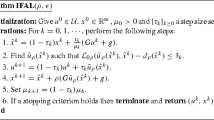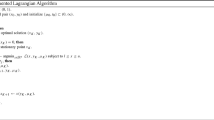Abstract
Lagrangian functions are the basis of many of the more successful methods for nonlinear constraints in optimization calculations. Sometimes they are used in conjunction with linear approximations to the constraints and sometimes penalty terms are included to allow the use of algorithms for unconstrained optimization. Much has been discovered about these techniques during the last eight years and this paper gives a view of the progress and understanding that has been achieved and its relevance to practical algorithms. A particular method is recommended that seems to be more powerful than the author believed to be possible at the beginning of 1976.
Similar content being viewed by others
References
D.P. Bertsekas, “Convergence rate of penalty and multiplier methods”,Proceedings of the 1973 IEEE Conference on Decision and Control (1973) 260–264.
D.P. Bertsekas, “Combined primal-dual and penalty methods for constrained minimization”,SIAM Journal on Control 13 (1975) 521–544.
D.P. Bertsekas, “Multiplier methods: a survey”,Automatica 12 (1976) 133–145.
M.C. Biggs, “Constrained minimization using recursive quadratic programming”, in: L.C.W. Dixon and G.P. Szegö, eds.,Towards global optimization (North-Holland, Amsterdam, 1975) pp. 341–349.
C.G. Broyden, “The convergence of a class of double-rank minimization algorithms 2. The new algorithm”,Journal of the Institute of Mathematics and its Applications 6 (1970) 222–231.
A.G. Buckley, “An alternate implementation of Goldfarb's minimization algorithm”,Mathematical Programming 8 (1975) 207–231.
J.D. Buys, “Dual algorithms for constrained optimization”, Ph.D. thesis, University of Leiden (Bronder-Offset, Rotterdam, 1972).
J.E. Dennis and J.J. Moré, “Quasi-Newton methods, motivation and theory”,SIAM Review 19 (1977) 46–89.
R. Fletcher, “A new approach to variable metric algorithms”,The Computer Journal 13 (1970) 317–322.
R. Fletcher, “Methods related to Lagrangian functions”, in: P.E. Gill and W. Murray, eds.,Numerical methods for constrained optimization (Academic Press, London, 1974) pp. 219–239.
R. Fletcher, “An ideal penalty function for constrained optimization”,Journal of the Institute of Mathematics and its Applications 15 (1975) 319–342.
R. Fletcher, “The quest for a natural metric”, presented at the ninth international symposium on mathematical programming, (Budapest, 1976).
U.M. Garcia-Palomares and O.L. Mangasarian, “Superlinearly convergent quasi-Newton algorithms for nonlinearly constrained optimization problems”,Mathematical Programming 11 (1976) 1–13.
S-P. Han, “Penalty Lagrangian methods in a quasi-Newton approach”, Report TR 75-252, Computer Science, Cornell University (Ithaca, 1975).
S-P. Han, “A globally convergent method for nonlinear programming”, Report TR 75-257, Computer Science, Cornell University (Ithaca, 1975).
S-P. Han, “Superlinearly convergent variable metric algorithms for general nonlinear programming problems”,Mathematical Programming 11 (1976) 263–282.
M.R. Hestenes, “Multiplier and gradient methods”,Journal of Optimization Theory and its Applications 4 (1969) 303–320.
G.P. McCormick, “Second order convergence using a modified Armijo step-size rule for function minimization”, presented at the ninth international symposium on mathematical programming (Budapest, 1976).
J.M. Ortega and W.C. Rheinboldt,Iterative solution of nonlinear equations in several variables (Academic Press, New York, 1970).
M.J.D. Powell, “A method for nonlinear constraints in minimization problems”, in: R. Fletcher, ed.,Optimization (Academic Press, London, 1969) pp. 283–298.
S.M. Robinson, “A quadratically convergent algorithm for general nonlinear programming problems”,Mathematical Programming 3 (1972) 145–156.
R.T. Rockafellar, “New applications of duality in convex programming”, presented at the seventh international symposium on mathematical programming (The Hague, 1970).
R.T. Rockafellar, “A dual approach to solving nonlinear programming problems by unconstrained optimization”,Mathematical Programming 5 (1973) 354–373.
J.B. Rosen and J. Kreuser, “A gradient projection algorithm for nonlinear constraints”, in: F.A. Lootsma, ed.,Numerical methods for nonlinear optimization (Academic Press, London, 1972) pp. 297–300.
D.M. Ryan, “Penalty and barrier functions”, in: P.E. Gill and W. Murray, eds.,Numerical methods for constrained optimization (Academic Press, London, 1974) pp. 175–190.
R.W.H. Sargent, “Reduced-gradient and projection methods for nonlinear programming”, in: P.E. Gill and W. Murray, eds.,Numerical methods for constrained optimization (Academic Press, London, 1974) pp. 149–174.
R.A. Tapia, “Diagonalized multiplier methods and quasi-Newton methods for constrained optimization”, manuscript (Rice University, Houstoń, 1976).
R.B. Wilson, “A simplical method for convex programming”, Ph.D. thesis, Harvard University (Cambridge, MA, 1963).
Author information
Authors and Affiliations
Rights and permissions
About this article
Cite this article
Powell, M.J.D. Algorithms for nonlinear constraints that use lagrangian functions. Mathematical Programming 14, 224–248 (1978). https://doi.org/10.1007/BF01588967
Received:
Revised:
Issue Date:
DOI: https://doi.org/10.1007/BF01588967




